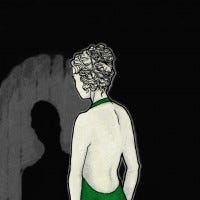Are some games better without graphics? Writer and designer Emily Short looks at The Shadow in the Cathedral, a work of interactive fiction that proves the strength of the format through the richness of its steampunk world.

[In this column, writer and designer Emily Short looks at The Shadow in the Cathedral, a work of interactive fiction that proves the strength of the format through the verbal illustrations of its steampunk world. ] I have a soft spot for steampunk; have done ever since I read The Iron Dragon's Daughter at an impressionable age. So it's with mixed pleasure and annoyance that I've watched the style become ubiquitous and diluted, until it means nothing more than an aesthetic of gears, ironmongery, and jugendstil curves. The Shadow in the Cathedral is set in a steampunk universe, but not in the same steampunk universe that everyone else is puttering about in. This is not The Mysterious Geographic Explorations of Jasper Morello, with its airships and cloudy vertical cities. It's not the oily, clanking, boiling environment celebrated by Vernian Process. This is a universe in which clockwork is not merely a means to an end, but a religion, a cult. Time is not only measured but made possible by the existence of cogs and winding key and pendulum. Newton, Babbage, and the swiss watchmaker Breguet are saints. The Goddess of Klockwerk visits good children at Newtonmass. The Difference Engine, the holy grail of steampunkery, is a mystical object: if you can just encode your question properly, it can answer anything there is to know about the universe. This is a game partly written for young people -- Textfyre's target market is middle-schoolers -- but it does not feel dumbed down. In developing this world, Shadow makes an argument for text as a living gaming medium -- not because it offers settings that would be difficult or expensive to render (though it does), but because there is so much attitude about the world that could not be captured effectively with visual images. An obvious example: "One thing's sure: she's a beautiful lady. Long gleaming hair like fresh oil, cheekbones arched like pinion arms." It's a set of similes unlikely to come into anyone's mind when looking at a picture of a beautiful woman, unless one's mind already belonged to the world of Klockwerk. The child protagonist, Wren, has been serving in the Abbey and has absorbed a surprising amount of mechanical knowledge, an assortment of odd social rules, and an ethical system based around orderliness and precision workmanship. These tidbits filter out at just the right rate. There are hints that the cult of clocks, and the society built around it, are not wholly positive: the conformist ritual of the monks, the venal sins of their superiors, the poverty on the streets, the pervasive sexism. Observing a squat and humorless lady, Wren thinks: "I've heard the monks mutter that it takes a certain kind of woman to work clockwork... What they mean, I don't know, but I guess this prim and awkward-looking woman must have it since she tends one of the most important machines in the world." It takes a deft touch to do this: Wren observes and does not explicitly comment on the monks' attitude, but nonetheless suggests to the reader ("one of the most important machines in the world") that perhaps that attitude should not be taken at face value. And there is other evidence in the game to undercut the idea that a technically competent woman must also be an unappealing one. Occasionally the prose is a little more verbose than I might like, but that's a matter of stylistic difference. The content is observant and memorable. These strengths don't stop at the world-building. Take these lines from a scene description early in the game: "But instead there's nothing but a single desk, some books, and a lot of wrought iron decoration - hooks, candle-brackets, ink-wells - all made from a single sweeping line of iron that curls around the floor and walls like a wandering pen-stroke." One could render those hooks, candle-brackets, and ink-wells in graphical form, given sufficient time and determination, and lay them out around the room. But the extra image, the image of the pen-stroke, is something no picture could convey. It accomplishes the poet's task of making the description more vivid than the thing described. Conversely, of some sinister tubes that may have been used for blood: "The insides of the tubes are the colour of burnt bacon." Disturbing, somehow, but not disturbing in the default way, and the slightly queasy wrongness is not something you could get across with a picture. Or take the moments of humor that explore the logical implications of this world, faintly reminiscent of Pratchett: "The telescope is made of finely-moulded brass stamped with the crossed lightning of the Weather Guild. Often accused of non-mechanism - weather's just too temperamental - they tend to build machines that are overly complicated, like the ratchet-and-piston umbrella they sell in the Cathedral Yard market..." The sense of a richly-imagined universe works itself out through all the puzzles and all the set pieces of the game. Puzzles that involve figuring out mysterious machinery are common in adventure games of all stripes, but "Shadow in the Cathedral" has its own distinctive style and does not leave the player feeling like he's just encountered a text version of Myst. The machines tend not to be handwaved as mysterious black boxes; instead many of them are described in exacting detail so that you can understand just how they are supposedly working. Even where complex machinery is not involved, many solutions turn on understanding some essential physical principle or other: the uses of levers, pulleys, counterweights, and contained gasses have rarely been so extensively explored in a game. Throughout The Shadow in the Cathedral I had a sense of delight at being allowed really to get my hands on the fun stuff, the mechanisms and whirligigs that give steampunk its aesthetic appeal. I was particularly pleased by a sequence that involved repurposing some weather-monitoring machinery. ("'Precipitometer'," Wren explains, "is a fancy name for 'thin bucket'.") It was all so much fun that I'm tempted to recount all the good bits until I've spoiled the thing completely. Shadow has many other virtues, and a few flaws as well. Flaws first: there are a handful of moments when I needed to turn to the hints because something was not sufficiently clear from room descriptions; there were bugs, not numerous but noticeable, which I hope Textfyre will remedy for future versions. And it is only fair to mention that the end of game leaves some important questions unresolved, to be handled in a sequel yet to come. But even with all that, "The Shadow in the Cathedral" is one of the best pieces of interactive fiction released this year. In its richness of plot and setting it reminded me most of Jimmy Maher's The King of Shreds and Patches. The pace is strong, and there is a surprising amount of action for IF -- chases, hiding places, confrontations, parkour-like scampering over surfaces not designed to be scampered. A lot happens. It took me seven or eight hours to play through, and I probably could have spent more time than that looking around. (And I did restore to several points in the game in order to have a closer look at things.) It's a solid adventure story, suitable for young adolescents but not at all limited to them, and it tells that story in a way that only text really could. [Emily Short is an interactive fiction author and part of the team behind Inform 7, a language for IF creation. She also maintains a blog on interactive fiction and related topics. She can be reached at emshort AT mindspring DOT com. She notes: 'Disclosure: I played a free review copy of this work.']
About the Author(s)
You May Also Like









